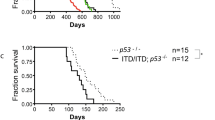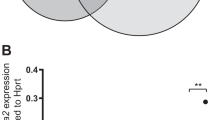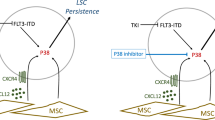Abstract
HOXA9, MEIS1 and FLT3 are genes frequently upregulated in human acute myeloid leukemia. Hoxa9 and Meis1 also cooperate to induce aggressive AML with high Flt3 expression in mice, suggesting an important role for Flt3 in Hoxa9/Meis1-induced leukemogenesis. To define the role of Flt3 in AML with high Hoxa9/Meis1, we treated mice with Hoxa9/Meis1-induced AML with the Flt3 inhibitor AC220, used an Flt3-ligand (FL−/−) knockout model, and investigated whether overexpression of Flt3 could induce leukemia together with overexpression of Hoxa9. Flt3 inhibition by AC220 did not delay AML development in mice transplanted with bone marrow cells overexpressing Hoxa9 and Meis1. In addition, Hoxa9/Meis1 cells induced AML in FL−/− mice as rapid as in wild-type mice. However, FL−/− mice had reduced organ infiltration compared with wild-type mice, suggesting some Flt3-dependent effect on leukemic invasiveness. Interestingly, leukemic Hoxa9/Meis1 cells from sick mice expressed high levels of Flt3 regardless of presence of its ligand, showing that Flt3 is a passive marker on these cells. In line with this, combined engineered overexpression of Flt3 and Hoxa9 did not accelerate the progression to AML. We conclude that the Hoxa9- and Meis1-associated upregulation of Flt3 is not a requirement for leukemic progression induced by Hoxa9 and Meis1.
This is a preview of subscription content, access via your institution
Access options
Subscribe to this journal
Receive 50 print issues and online access
$259.00 per year
only $5.18 per issue
Buy this article
- Purchase on Springer Link
- Instant access to full article PDF
Prices may be subject to local taxes which are calculated during checkout





Similar content being viewed by others
References
Frohling S, Schlenk RF, Breitruck J, Benner A, Kreitmeier S, Tobis K et al. Prognostic significance of activating FLT3 mutations in younger adults (16 to 60 years) with acute myeloid leukemia and normal cytogenetics: a study of the AML Study Group Ulm. Blood 2002; 100: 4372–4380.
Kuchenbauer F, Kern W, Schoch C, Kohlmann A, Hiddemann W, Haferlach T et al. Detailed analysis of FLT3 expression levels in acute myeloid leukemia. Haematologica 2005; 90: 1617–1625.
Nakao M, Yokota S, Iwai T, Kaneko H, Horiike S, Kashima K et al. Internal tandem duplication of the flt3 gene found in acute myeloid leukemia. Leukemia 1996; 10: 1911–1918.
Staffas A, Kanduri M, Hovland R, Rosenquist R, Ommen HB, Abrahamsson J et al. Presence of FLT3-ITD and high BAALC expression are independent prognostic markers in childhood acute myeloid leukemia. Blood 2011; 118: 5905–5913.
Konig H, Levis M . Targeting FLT3 to treat leukemia. Expert Opin Ther Targets 2015; 19: 37–54.
Drabkin HA, Parsy C, Ferguson K, Guilhot F, Lacotte L, Roy L et al. Quantitative HOX expression in chromosomally defined subsets of acute myelogenous leukemia. Leukemia 2002; 16: 186–195.
Huang Y, Sitwala K, Bronstein J, Sanders D, Dandekar M, Collins C et al. Identification and characterization of Hoxa9 binding sites in hematopoietic cells. Blood 2012; 119: 388–398.
Kroon E, Krosl J, Thorsteinsdottir U, Baban S, Buchberg AM, Sauvageau G . Hoxa9 transforms primary bone marrow cells through specific collaboration with Meis1a but not Pbx1b. EMBO J 1998; 17: 3714–3725.
Argiropoulos B, Palmqvist L, Yung E, Kuchenbauer F, Heuser M, Sly LM et al. Linkage of Meis1 leukemogenic activity to multiple downstream effectors including Trib2 and Ccl3. Exp Hematol 2008; 36: 845–859.
Wang GG, Pasillas MP, Kamps MP . Meis1 programs transcription of FLT3 and cancer stem cell character, using a mechanism that requires interaction with Pbx and a novel function of the Meis1 C-terminus. Blood 2005; 106: 254–264.
Palmqvist L, Pineault N, Wasslavik C, Humphries RK . Candidate genes for expansion and transformation of hematopoietic stem cells by NUP98-HOX fusion genes. PLoS One 2007; 2: e768.
Palmqvist L, Argiropoulos B, Pineault N, Abramovich C, Sly LM, Krystal G et al. The Flt3 receptor tyrosine kinase collaborates with NUP98-HOX fusions in acute myeloid leukemia. Blood 2006; 108: 1030–1036.
Morgado E, Albouhair S, Lavau C . Flt3 is dispensable to the Hoxa9/Meis1 leukemogenic cooperation. Blood 2007; 109: 4020–4022.
Zarrinkar PP, Gunawardane RN, Cramer MD, Gardner MF, Brigham D, Belli B et al. AC220 is a uniquely potent and selective inhibitor of FLT3 for the treatment of acute myeloid leukemia (AML). Blood 2009; 114: 2984–2992.
Kampa-Schittenhelm KM, Heinrich MC, Akmut F, Dohner H, Dohner K, Schittenhelm MM . Quizartinib (AC220) is a potent second generation class III tyrosine kinase inhibitor that displays a distinct inhibition profile against mutant-FLT3, -PDGFRA and -KIT isoforms. Mol Cancer 2013; 12: 19.
Taylor SJ, Dagger SA, Thien CB, Wikstrom ME, Langdon WY . Flt3 inhibitor AC220 is a potent therapy in a mouse model of myeloproliferative disease driven by enhanced wild-type Flt3 signaling. Blood 2012; 120: 4049–4057.
McKenna HJ, Stocking KL, Miller RE, Brasel K, De Smedt T, Maraskovsky E et al. Mice lacking flt3 ligand have deficient hematopoiesis affecting hematopoietic progenitor cells, dendritic cells, and natural killer cells. Blood 2000; 95: 3489–3497.
Kogan SC, Ward JM, Anver MR, Berman JJ, Brayton C, Cardiff RD et al. Bethesda proposals for classification of nonlymphoid hematopoietic neoplasms in mice. Blood 2002; 100: 238–245.
Brasel K, Escobar S, Anderberg R, de Vries P, Gruss HJ, Lyman SD . Expression of the flt3 receptor and its ligand on hematopoietic cells. Leukemia 1995; 9: 1212–1218.
Lisovsky M, Braun SE, Ge Y, Takahira H, Lu L, Savchenko VG et al. Flt3-ligand production by human bone marrow stromal cells. Leukemia 1996; 10: 1012–1018.
Stirewalt DL, Radich JP . The role of FLT3 in haematopoietic malignancies. Nat Rev Cancer 2003; 3: 650–665.
Thorsteinsdottir U, Mamo A, Kroon E, Jerome L, Bijl J, Lawrence HJ et al. Overexpression of the myeloid leukemia-associated Hoxa9 gene in bone marrow cells induces stem cell expansion. Blood 2002; 99: 121–129.
Li Z, Zhang Z, Li Y, Arnovitz S, Chen P, Huang H et al. PBX3 is an important cofactor of HOXA9 in leukemogenesis. Blood 2013; 121: 1422–1431.
Christensen JL, Weissman IL . Flk-2 is a marker in hematopoietic stem cell differentiation: a simple method to isolate long-term stem cells. Proc Natl Acad Sci USA 2001; 98: 14541–14546.
Kikushige Y, Yoshimoto G, Miyamoto T, Iino T, Mori Y, Iwasaki H et al. Human Flt3 is expressed at the hematopoietic stem cell and the granulocyte/macrophage progenitor stages to maintain cell survival. J Immunol 2008; 180: 7358–7367.
Smith BD, Levis M, Beran M, Giles F, Kantarjian H, Berg K et al. Single-agent CEP-701, a novel FLT3 inhibitor, shows biologic and clinical activity in patients with relapsed or refractory acute myeloid leukemia. Blood 2004; 103: 3669–3676.
Stone RM, DeAngelo DJ, Klimek V, Galinsky I, Estey E, Nimer SD et al. Patients with acute myeloid leukemia and an activating mutation in FLT3 respond to a small-molecule FLT3 tyrosine kinase inhibitor, PKC412. Blood 2005; 105: 54–60.
Rathinam C, Thien CB, Flavell RA, Langdon WY . Myeloid leukemia development in c-Cbl RING finger mutant mice is dependent on FLT3 signaling. Cancer Cell 2010; 18: 341–352.
Imamura T, Morimoto A, Takanashi M, Hibi S, Sugimoto T, Ishii E et al. Frequent co-expression of HoxA9 and Meis1 genes in infant acute lymphoblastic leukaemia with MLL rearrangement. Br J Haematol 2002; 119: 119–121.
Balgobind BV, Zwaan CM, Pieters R, Van den Heuvel-Eibrink MM . The heterogeneity of pediatric MLL-rearranged acute myeloid leukemia. Leukemia 2011; 25: 1239–1248.
Shen Y, Zhu YM, Fan X, Shi JY, Wang QR, Yan XJ et al. Gene mutation patterns and their prognostic impact in a cohort of 1185 patients with acute myeloid leukemia. Blood 2011; 118: 5593–5603.
Pineault N, Buske C, Feuring-Buske M, Abramovich C, Rosten P, Hogge DE et al. Induction of acute myeloid leukemia in mice by the human leukemia-specific fusion gene NUP98-HOXD13 in concert with Meis1. Blood 2003; 101: 4529–4538.
SB H, SR C, WS B, D G, TB N. Designing clinical research: an epidemiologic approach. 4th edn. 2013.
Acknowledgements
We wish to thank Carina Wasslavik, Christina Nilsson, and Susanne Li for valuable technical assistance. This work was supported by grants to LP from the Swedish Cancer Society (CAN2014/525) and the Västra Götalandsregionen (ALFGBG-431881). FK was supported by grants from Deutsche Krebshilfe grant 109420 (Max-Eder program), fellowship 2010/04 by the European Hematology Association, and by the Deutsche Forschungsgemeinschaft (SFB 1074, project A5). SYW was supported by a grant from Assar Gabrielsson’s foundation.
Author information
Authors and Affiliations
Corresponding author
Ethics declarations
Competing interests
The authors declare no conflict of interest.
Additional information
Supplementary Information accompanies this paper on the Oncogene website
Supplementary information
Rights and permissions
About this article
Cite this article
Staffas, A., Arabanian, L., Wei, S. et al. Upregulation of Flt3 is a passive event in Hoxa9/Meis1-induced acute myeloid leukemia in mice. Oncogene 36, 1516–1524 (2017). https://doi.org/10.1038/onc.2016.318
Received:
Revised:
Accepted:
Published:
Issue Date:
DOI: https://doi.org/10.1038/onc.2016.318
This article is cited by
-
PRICKLE1, a Wnt/PCP signaling component, is overexpressed and associated with inferior prognosis in acute myeloid leukemia
Journal of Translational Medicine (2021)
-
Syngeneic leukemia models using lentiviral transgenics
Cell Death & Disease (2021)
-
High WBP5 expression correlates with elevation of HOX genes levels and is associated with inferior survival in patients with acute myeloid leukaemia
Scientific Reports (2020)
-
Mutated NPM1 in combination with overexpression of Meis1 or Hoxa9 is not sufficient to induce acute myeloid leukemia
Experimental Hematology & Oncology (2015)



